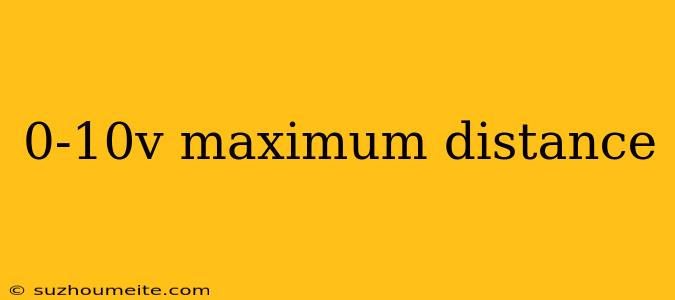0-10V Maximum Distance: Understanding the Limitations of Analog Signal Transmission
Introduction
In industrial automation and process control systems, 0-10V analog signals are widely used to transmit information between sensors, transmitters, and control devices. These signals are used to measure physical parameters such as temperature, pressure, flow rate, and level. However, there are limitations to the distance over which these signals can be transmitted reliably. In this article, we will discuss the maximum distance for 0-10V analog signal transmission and the factors that affect it.
What is 0-10V Analog Signal?
A 0-10V analog signal is a continuous voltage signal that varies between 0 volts and 10 volts to represent a physical parameter. This signal is generated by a sensor or transmitter and transmitted to a control device, such as a PLC or DCS, for processing and control. The 0-10V range is commonly used in industrial automation due to its simplicity, reliability, and compatibility with most control devices.
Maximum Distance for 0-10V Analog Signal Transmission
The maximum distance for 0-10V analog signal transmission depends on several factors, including:
Cable Length and Type
The length and type of cable used for signal transmission greatly affect the maximum distance. Longer cables and those with higher resistance and capacitance can attenuate the signal, reducing the maximum distance. Typically, a maximum cable length of 300-500 meters is recommended for 0-10V analog signal transmission.
Signal Noise and Interference
Electrical noise and interference from nearby devices, power lines, and radio frequency interference (RFI) can also affect the maximum distance. Noise and interference can corrupt the signal, causing errors and reducing the reliability of the transmission.
Signal Amplitude and Rise Time
The amplitude and rise time of the signal also impact the maximum distance. A higher signal amplitude and faster rise time can improve the signal-to-noise ratio, allowing for longer transmission distances.
Environment and Installation
The environment and installation conditions, such as temperature, humidity, and vibration, can also affect the maximum distance. For example, signal transmission in high-temperature or noisy environments may require shorter cable lengths or additional noise shielding.
Factors Affecting Signal Attenuation
Signal attenuation is a critical factor in determining the maximum distance for 0-10V analog signal transmission. Attenuation occurs when the signal is reduced in amplitude due to resistance, capacitance, and inductance in the cable. The main factors affecting signal attenuation are:
Cable Resistance
The resistance of the cable, measured in ohms (Ω), increases with length and reduces the signal amplitude.
Cable Capacitance
The capacitance of the cable, measured in farads (F), affects the signal's rise time and frequency response.
Cable Inductance
The inductance of the cable, measured in henries (H), affects the signal's frequency response and can cause signal ringing.
Conclusion
The maximum distance for 0-10V analog signal transmission is influenced by several factors, including cable length and type, signal noise and interference, signal amplitude and rise time, and environment and installation conditions. Understanding these factors is crucial in designing and implementing reliable analog signal transmission systems in industrial automation and process control applications. By considering these factors, engineers can ensure accurate and reliable signal transmission over long distances.
